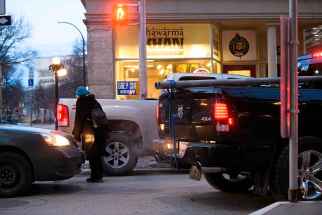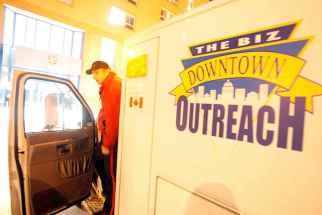Changing perceptions of downtown safety
Read this article for free:
or
Already have an account? Log in here »
To continue reading, please subscribe:
Monthly Digital Subscription
$0 for the first 4 weeks*
- Enjoy unlimited reading on winnipegfreepress.com
- Read the E-Edition, our digital replica newspaper
- Access News Break, our award-winning app
- Play interactive puzzles
*No charge for 4 weeks then price increases to the regular rate of $19.00 plus GST every four weeks. Offer available to new and qualified returning subscribers only. Cancel any time.
Monthly Digital Subscription
$4.75/week*
- Enjoy unlimited reading on winnipegfreepress.com
- Read the E-Edition, our digital replica newspaper
- Access News Break, our award-winning app
- Play interactive puzzles
*Billed as $19 plus GST every four weeks. Cancel any time.
To continue reading, please subscribe:
Add Free Press access to your Brandon Sun subscription for only an additional
$1 for the first 4 weeks*
*Your next subscription payment will increase by $1.00 and you will be charged $16.99 plus GST for four weeks. After four weeks, your payment will increase to $23.99 plus GST every four weeks.
Read unlimited articles for free today:
or
Already have an account? Log in here »
Hey there, time traveller!
This article was published 28/11/2019 (2206 days ago), so information in it may no longer be current.
Having sufficient numbers of people living and working downtown to foster a safe, street-level environment is an admirable goal. However, it’s also a chicken-and-egg problem: people need to feel safe downtown before they’ll be willing to spend a large amount of time there; and without enough human activity on the downtown streets, people won’t feel safe.
The city has had downtown safety on its radar for many years, in terms of policing, improving transportation and infrastructure, and partnering with groups such as the Downtown Winnipeg Business Improvement Zone. Now, a coalition of local groups is collaborating on a pilot project to improve safety.
The project, Downtown Safety Partnership, was launched on Nov. 18 by the Downtown Winnipeg BIZ, True North Sports and Entertainment Ltd., the City of Winnipeg and the Winnipeg Police Service. Organizers are looking at what has worked in other cities such as Calgary, Edmonton and Minneapolis.

Minneapolis, for example, has built partnerships between community organizations, the police, social outreach initiatives and private security firms, among others, to address challenges in its downtown.
Has it worked? According to the Minneapolis Downtown Improvement District’s 2018 annual report, public perceptions on top safety concerns improved: 37 per cent of respondents had no safety concerns, up from 33 per cent in 2017.
Winnipeg’s Downtown BIZ has taken part in similar activities and partnerships for many years. Foot patrols often serve as a first point of contact for visitors and residents alike. The Downtown BIZ also co-ordinates with local law enforcement, private businesses in the area and a Community Homeless Assistance Team.
Over time, Winnipeg’s downtown has actually become safer. According to the statistics from the Winnipeg Police Service, crimes against people and property in the downtown have been decreasing since 2001. The BIZ highlights the fact that while police statistics show a decrease in crime across the city of 26 per cent since 2011, in the downtown that decrease was steeper, at 44 per cent.

Of course, people don’t make decisions on whether to live, work or shop downtown by pulling out a ream of crime stats. A great deal is based on perception, and one bad experience in person or relayed by a friend can weigh heavily.
Fortunately, co-ordinated efforts can have an effect there, too. As in Minneapolis, Winnipeg’s downtown has seen some improvement on the vague “feels safer” metric. Surveys of city residents showed an increasing number who “feel safe walking alone downtown at night” from 2016/17 (25 per cent) to 2018 (28 per cent), but the number fell to 14 per cent in 2019.
(It’s worth noting that for those who actually live in the downtown and inner city, the percentages of those who feel safe downtown alone at night are higher, at 49 per cent and 47 per cent, respectively.)
It raises the question: when suburb dwellers make a rare trip downtown and observe panhandlers, youths or people of a different ethnicity, do those differences make them feel “unsafe” or merely “uncomfortable”? They aren’t the same thing. And no amount of policing is going to make poverty disappear, nor will making sure sidewalk litter is picked up erase unwarranted unease about another person’s skin colour.
The Downtown Safety Partnership is a worthwhile venture, and should improve both safety and the quality of life downtown. But more Winnipeggers should ask themselves whether it’s concerns about safety, or just fear of the unfamiliar, that’s keeping them away from the city’s centre.











